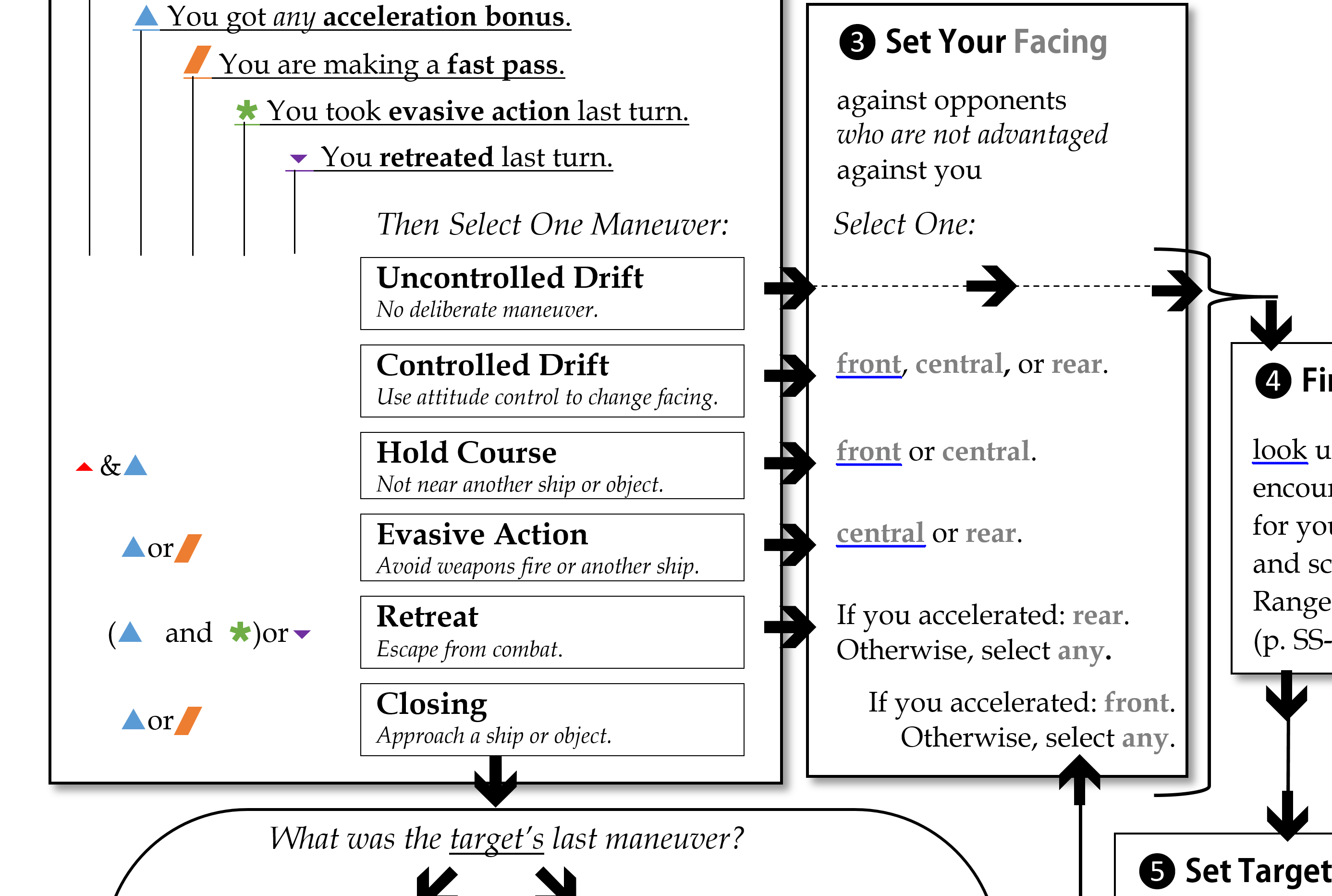It’s a free fan-produced game aid! Download the GURPS Spaceships basic space combat Pilot Move flowchart v. 1 in either PDF or Microsoft Word for GURPS 4th edition:
Download PDF:
Download Editable Microsoft Word .docx
How to Use It:
It’s taken me a while to get my head around the GURPS Spaceships basic space combat system. I often play map-less, and I think there are some interesting things in this map-less combat system and I wanted to learn it. But I had a hard time figuring out what I was supposed to be doing in the movement phase. I drew this flowchart to help ME understand the rules, but I’m posting it here in case other people would benefit from this sort of explanation. Here’s a quick discussion based on my recent sample combats (which were all two ship dogfights).
From what I can tell, the way I should have thought about it from the start is that the range table on SS p. 57 is the key to maneuvering in space combat. Everyone starts at the “neutral” range listed at the bottom for the kind of engagement they are in. Maneuvering in space combat is about pilots trying to “climb” up the table from the bottom to decrease the range (or the opposite: pilots trying to prevent this from happening). In short:
The most important purpose of maneuvering is either (1) trying to succeed at the “closing” maneuver (the only maneuver that requires a dice roll) so that you can change your range to a closer one, or trying to (2) prevent other players from succeeding at a closing maneuver.
A much-less-important purpose of maneuvering is to change facing. Changing facing is relevant if you are trying to target a particular system on the enemy ship (or hide your own weak point), but this is an unlikely scenario. A much more likely purpose will be changing range.
Range is pretty darn relevant if you have beam weapons, as they might not work at long range. Conversely, if you have long-range missiles and your opponent has beams, you may want to stay away from them. So the maneuver phase, a big part of space combat, is a kind of dance toward and away from the default “neutral” range on the bottom of the SS p. 57 table. Big picture, that’s most of what is going on.
A problem with this is that in my combats missiles were so overpowered that maneuvering just didn’t matter that much. If I disallow missiles or otherwise restrict them this might change things.
Maneuvering tactics:
After some experiments, I think I’ve figured out my goals as a pilot. I feel that I’m supposed to…
- Choose Closing to get closer, to change facing, or to foil an opponent’s retreat.
- Choose Hold Course to hold onto your engaged (closer) status once you’ve achieved it.
- Choose Evasive Action to get farther away or to set-up for a later retreat.
- Choose Retreat to escape the engagement, but I can only do this after one turn of Evasive Action.
- Use Controlled Drift to change facing if you don’t meet the requirements of the other maneuvers, or if you want someone to get closer to you.
- Be forced to take an Uncontrolled Drift if I can’t do anything else.
Maybe it was obvious to other readers but I had quite a hard time intuiting what the maneuvers were intended to be for. No School Grognard’s published space combat has been essential in helping me figure this out.
Outstanding Maneuvering Issues
One thing that this flowchart (and No School Grognard’s combat) makes clear: it appears impracticably difficult for auxiliary craft to land using this system (e.g., for fighters to land on a carrier). The “Success by 10+” requirement for rendezvous seems very challenging!
Has this been fixed? Not sure. Maybe it is not a mistake, and the system assumes that the only rendezvous that matter are boarding actions, so they should be hard. Peaceful landings can be accomplished out of combat with the standard Piloting skill rules (?). Just a theory.
Design Notes/Change Log
- I put this in Microsoft Word so that it is easily editable. Fix my mistakes!
- I embedded the fonts in the Word document so that other people can make changes that suit their own play style


1 Comment